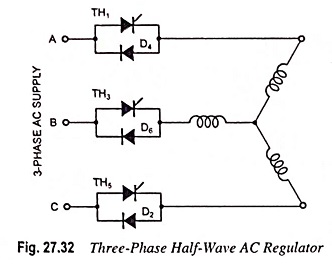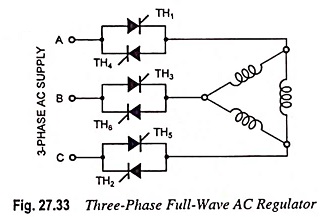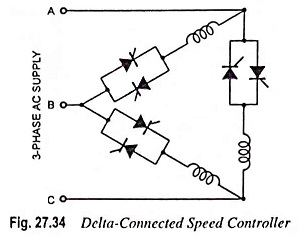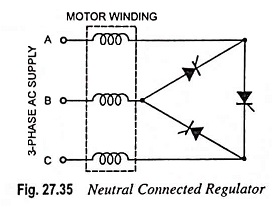AC Regulator – Definition and Classification:
An ac regulator converts a constant ac voltage into a variable ac voltage of the same frequency. No doubt, ac voltage level can be changed by auto-transformer, tap-changing transformer, saturable reactors etc. These devices have been in use for long time and still are in use. But ac regulators using thyristors and triacs are becoming more and more popular because of their high efficiency, fast control and compact size. However, ac regulators using thyristors and triacs introduce objectionable harmonics in the circuits.
Classification:
AC regulators are classified as single-phase or three-phase. Each of these may be half-wave (i.e., unidirectional) or full-wave (i.e., bidirectional).
Since the input to an ac regulator is ac, it is always line commutated. Therefore, forced commutation is not required. As such the circuits of ac regulators are quite simple. Two types of controls are used in ac regulators. These are known as integral cycle control and phase control.
In an integral cycle control, also known as on-off control, the thyristors are used as switches to connect the motor to the supply source for a certain number of cycles of the source voltage and then to disconnect it for another certain number of cycles. Each of the on- and off-times consists of an integral number of cycles. Thyristors are switched on by gate pulses at zero voltage crossing of input voltage.
In phase control, the thyristors are employed as switches for connecting the motor to the supply for a certain portion of each cycle of the supply voltage. Most ac regulators use phase control. The power circuit configurations for integral cycle control and phase control do not differ in any manner.
Smooth variation of three-phase ac voltage can be realized by means of different configurations of the power circuit.
The three-phase regulators, as already said, may be half-wave or full-wave. Circuit of three-phase half-wave regulator for delta-connected motors or star-connected motors in which neutral point is not accessible is shown in Fig. 27.32. This circuit uses three thyristors and three diodes. Though half-wave ac regulator illustrated in Fig. 27.32 affects a saving in the cost of semiconductor devices and does not give rise to dc components in any part of the system but it introduces more harmonics into the line current than does the full-wave regulator. Half-wave circuit is not used in actual practice.
Figure 27.33 shows a 3-phase full-wave regulator. It uses 6 thyristors, 2 for each phase. The input transformer may or may not be employed. As regards the heating of motor windings are concerned, star-connected motor supplied through a full-wave ac regulator is preferred over a delta-connected motor supplied through a full-wave ac regulator. This is so, because any third harmonic voltages generated by the motor back emf can cause circulating currents in case of delta-connected motor.
For delta-connected load circuits in which each end of each phase is accessible, the arrangement illustrated in Fig. 27.34 is employed. This arrangement has the advantage of reducing the current of the device as it has to carry now 1/√3 of the current if they were connected in the line of the delta winding. Once the phase current wave is known, the line current wave can be constructed by superposition.
For star-connected load circuits in which neutral point is accessible and can be opened, the arrangement illustrated in Fig. 27.35 may be used. In this arrangement, the number of thyristors required reduces to three and control circuitry becomes considerably simplified. The power consumption of the motor may be as high 100% greater than that with sine wave voltage control especially at reduced speeds.



